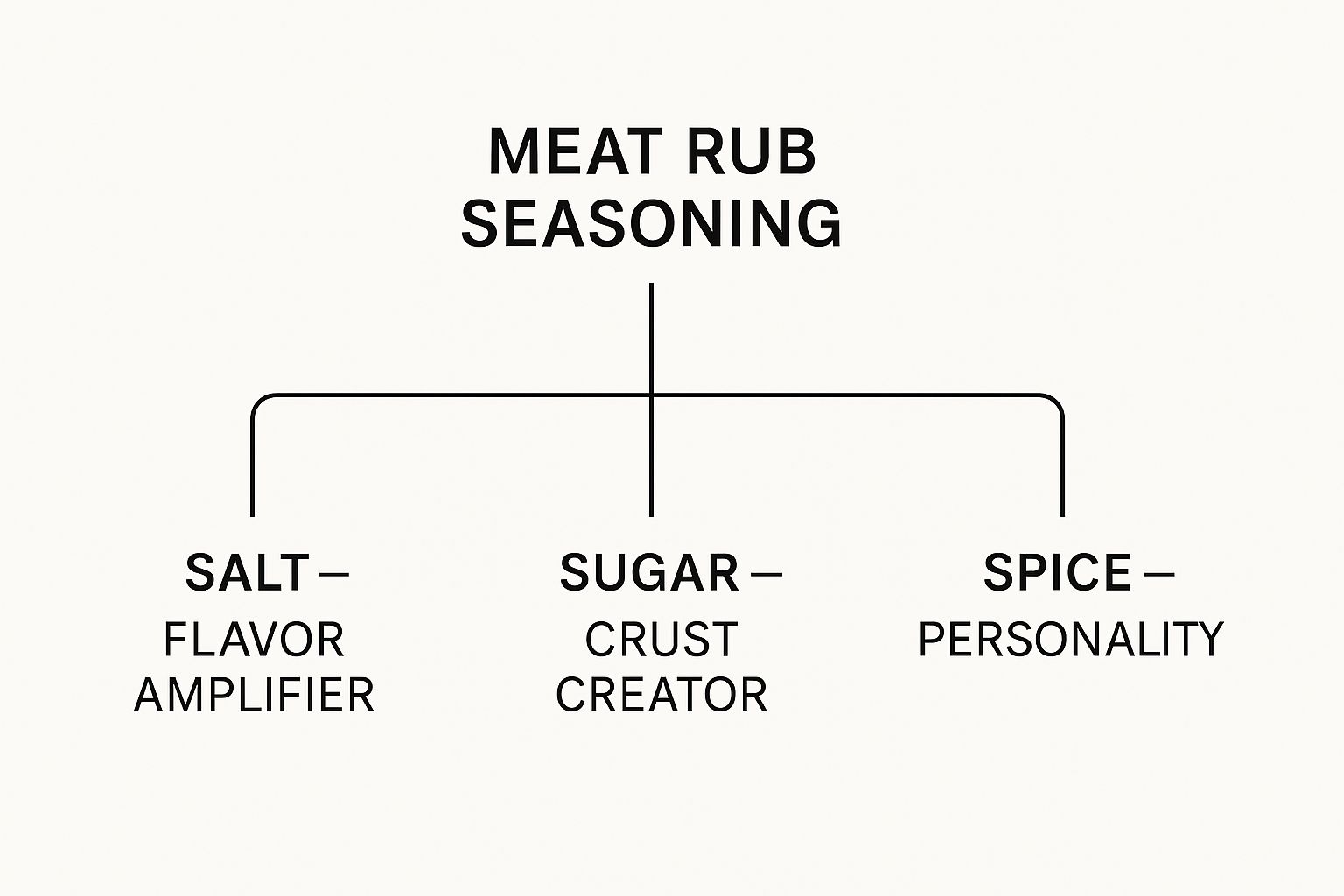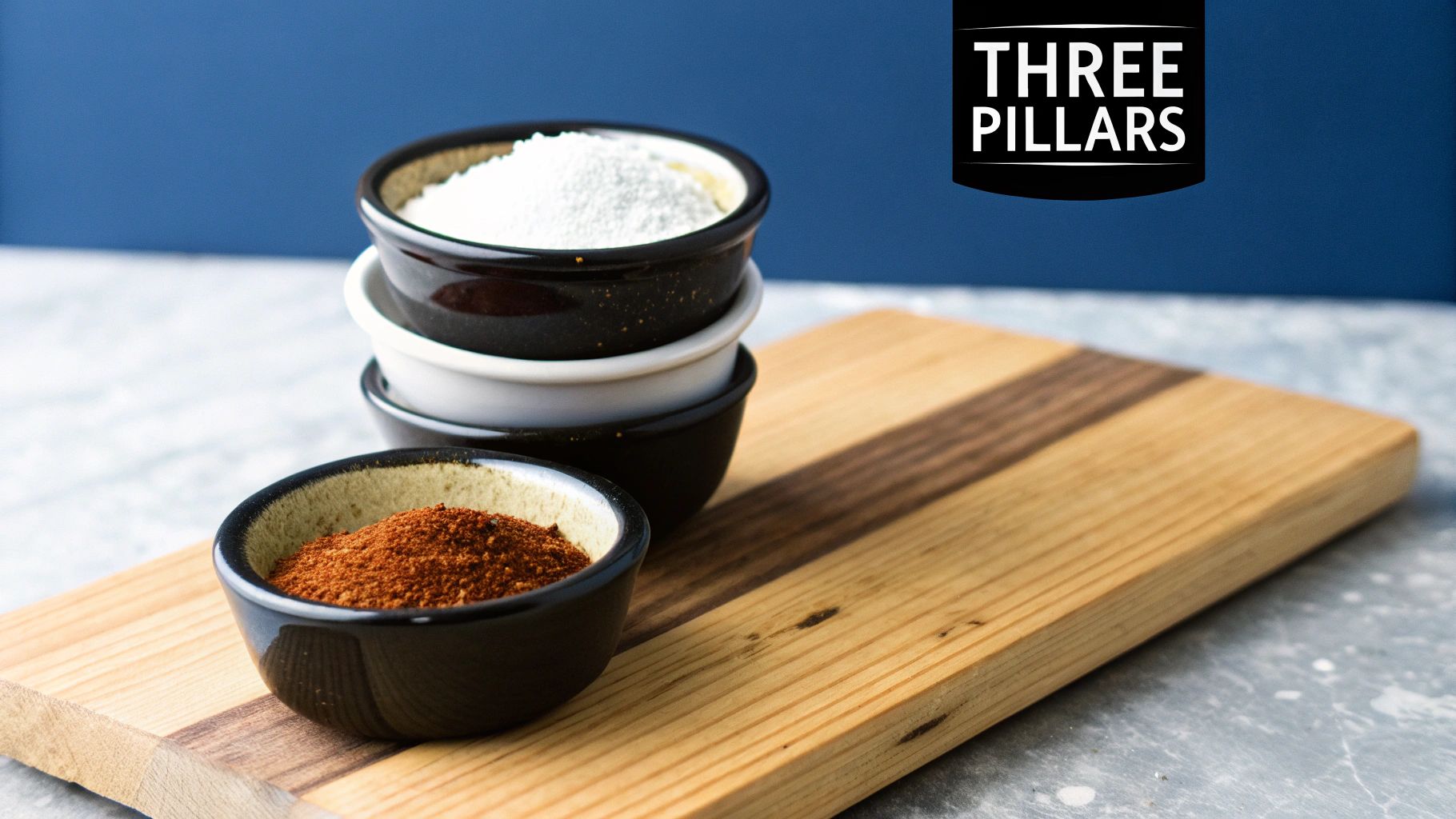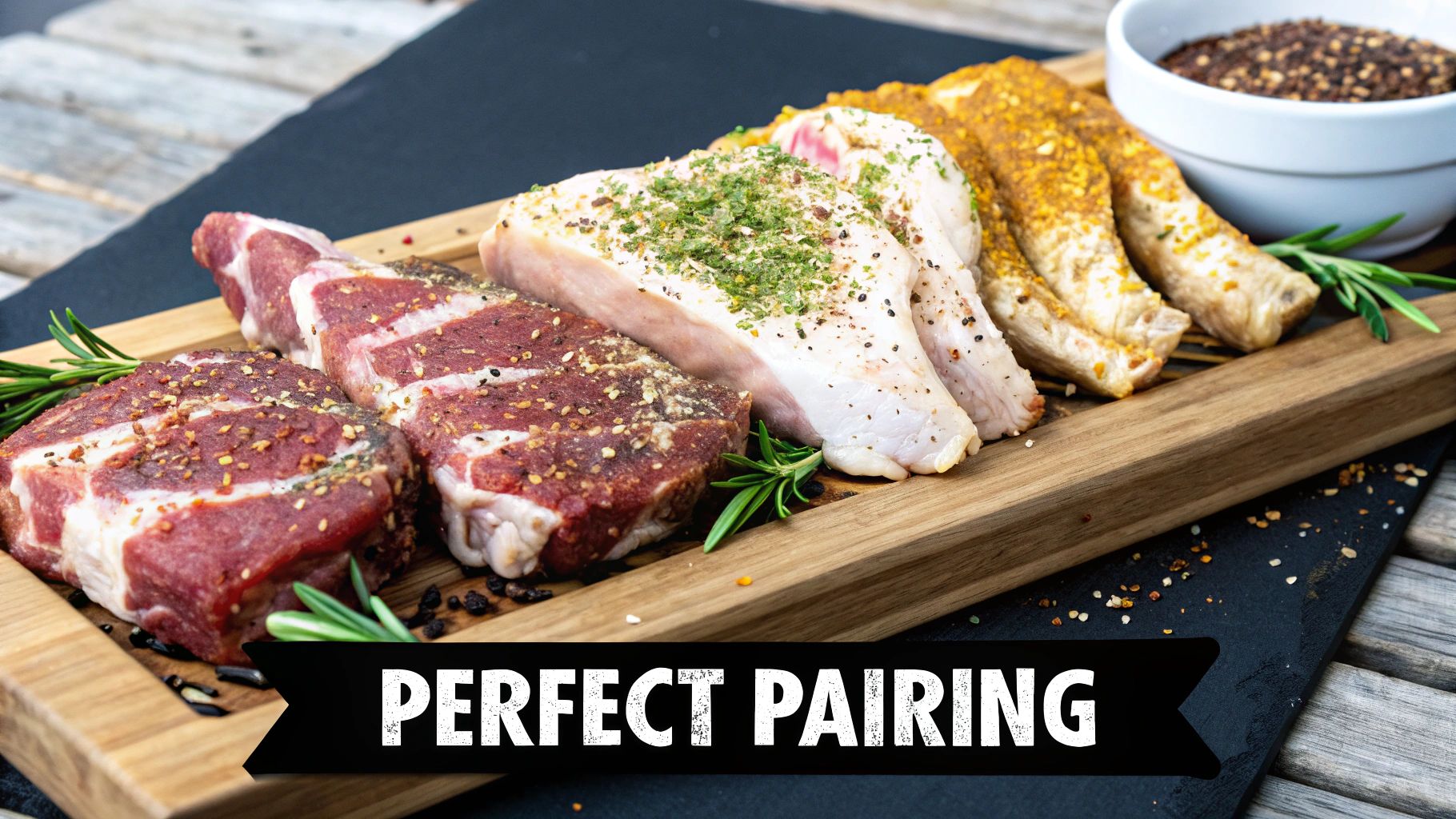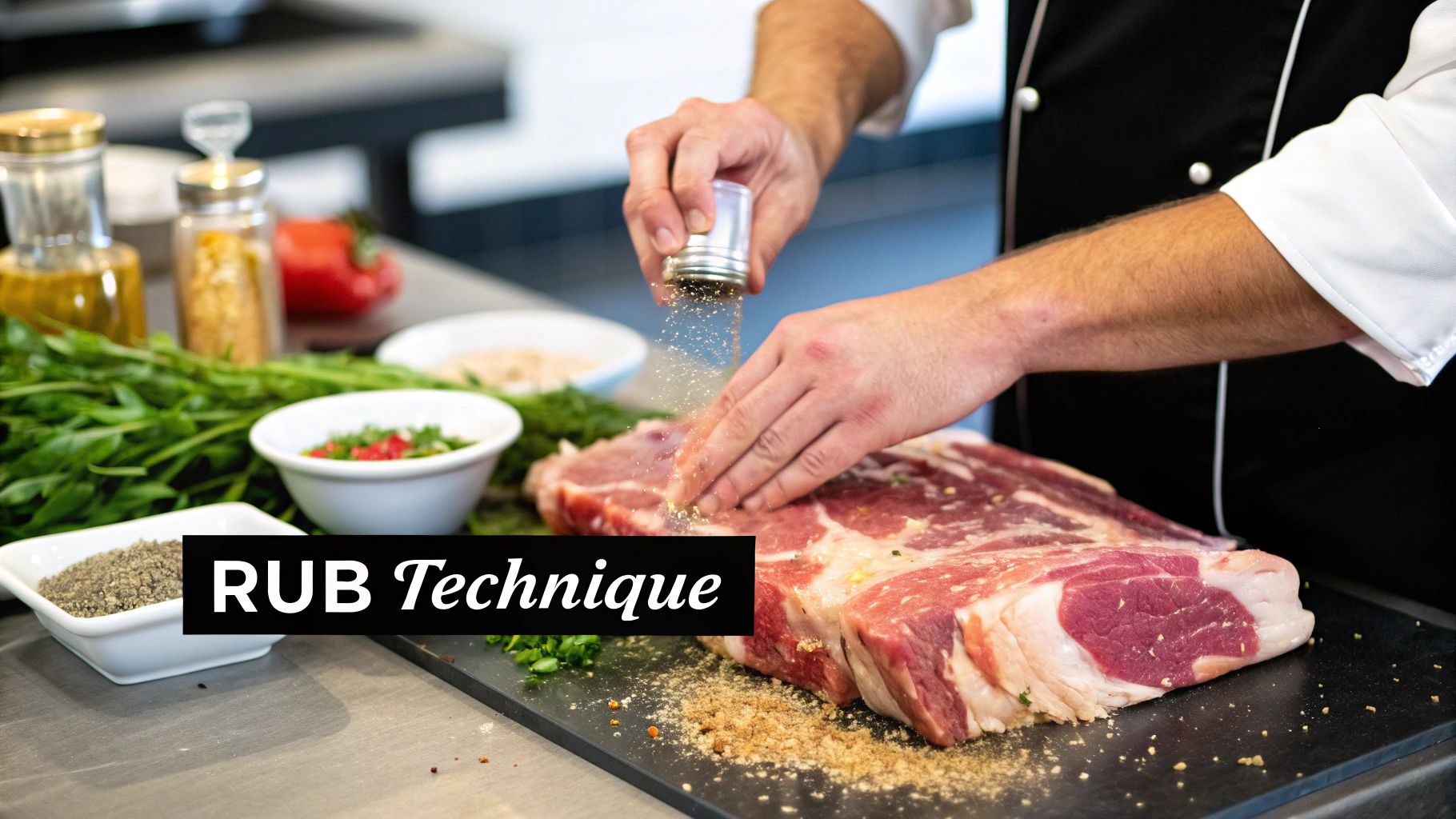Unlocking Flavour with Meat Rub Seasoning
A meat rub is your secret weapon for packing incredible flavour into your cooking. Think of it as a dry blend of salt, sugar, and spices that you apply directly to meat before it hits the heat.
So, what makes a rub different from a marinade? Instead of soaking in, a rub’s job is to create a savoury, textured crust—often called 'bark' in the BBQ world—that locks in moisture and seriously boosts the meat's natural taste.
What Is Meat Rub Seasoning, Anyway?
Let's cut through the jargon. At its heart, a meat rub is a simple concept with a powerful impact. It's the fastest way to build layers of complex flavour on everything from chicken wings to a full brisket, turning a good meal into a great one.
Unlike marinades, which work by soaking into the meat, a dry rub works its magic right on the surface. As it cooks, the ingredients toast and caramelise, forming that irresistible crust. This not only delivers a punch of flavour with every bite but also helps seal in the meat’s natural juices, keeping it tender and succulent.
The explosion in popularity of barbecue and home cooking has put meat rubs squarely in the spotlight. In fact, the global meat seasonings market, valued at USD 5.6 billion in 2025, is projected to nearly double by 2035. This huge growth shows a massive shift towards creating flavour-packed, convenient meals at home—something a quality rub makes incredibly easy.
The Core Components of a Great Rub
Every truly effective meat rub balances three fundamental elements. Each one plays a crucial role in the final result, and understanding how they work together is the first step to mastering your seasoning game.
- Salt: This is the flavour amplifier. Salt draws moisture to the surface of the meat, which then dissolves the salt and other spices, helping them penetrate a little deeper for a more seasoned result.
- Sugar: Meet the crust creator. Sugars like brown sugar or coconut sugar caramelise under heat, creating that signature dark, crunchy bark that is the hallmark of great barbecue.
- Spice: This is where the personality comes from. The spice blend is what defines a rub’s character and culinary identity, bringing authentic cultural flavours to life—from smoky paprika to earthy cumin.
This diagram shows how these three pillars form the foundation of any meat rub.

It’s clear that salt, sugar, and spice aren't just ingredients; they are functional components that work together to create flavour, texture, and aroma. A quality blend focuses on balancing these three without any unnecessary fillers or "added crap."
For a deeper dive into what makes a superior seasoning, you might be interested in our guide to the benefits of using dry rubs for meat.
The Three Pillars of a Perfect Rub

Every truly great meat rub is built on a foundation of three things: salt, sugar, and spice. Think of them as the ultimate flavour trio, working in perfect harmony to turn a decent cut of meat into something unforgettable. Understanding the role each one plays is the real secret to unlocking incredible barbecue.
A well-crafted rub isn't just a random handful of powders; it's a balanced formula where every single ingredient has a critical job to do. Getting that balance right is what separates an average home cook from a genuine flavour pioneer.
Salt: The Flavour Amplifier
Salt is the absolute workhorse of any rub. Its main job is to amplify the natural flavour of the meat through a bit of science called osmosis. Essentially, the salt draws moisture out of the meat, which then dissolves the salt and all the other seasonings, creating a super-concentrated brine that gets pulled right back in.
This process is brilliant for two reasons. First, it seasons the meat far deeper than just the surface. Second, it actually helps the meat hold onto its own moisture during a long, slow cook, giving you a much juicier result. Salt is the foundation that makes everything else taste better.
Sugar: The Crust Creator
If salt is the workhorse, then sugar is the artist. When it hits the heat, sugars like brown sugar or coconut sugar start to caramelise. This is part of the legendary Maillard reaction, and it's responsible for creating that deep, dark, and irresistibly crunchy crust on barbecue – what we all know and love as the ‘bark’.
The bark is more than just texture; it's a complex layer of concentrated flavour that provides a satisfying contrast to the tender, smoky meat underneath. Nailing that perfect bark is a true hallmark of great barbecue.
Without sugar, you’d miss out on this signature element entirely. It also adds a subtle sweetness that cuts through the savoury salt and spices, creating a well-rounded flavour profile that has you reaching for another bite.
Spice: The Personality
This is where a rub gets its soul. The spice blend is what defines the character and personality of the seasoning. From the smoky warmth of paprika to the earthy notes of cumin or the bright kick of cayenne, the spices are what make a rub unique.
We're all about authentic, global flavours without any cheap fillers or "added crap," all delivered in our unique craft can packaging to keep things fresh. And it seems everyone else is, too. The global market for spices in meat, valued at USD 16.56 billion in 2024, is set to rocket to USD 28.45 billion by 2032. This surge is being driven by home cooks in the UK and beyond who are hungry for authentic, ethnic spice blends to level up their meals. You can dig into the numbers yourself in this detailed market research report.
This is exactly why we meticulously source our spices, ensuring every blend tells a story and delivers a flavour experience you won't forget. The right spices turn a simple piece of meat into a culinary journey.
To give you a better idea of how it all works, here's a quick look at some common ingredients and the roles they play.
Key Rub Ingredients and Their Flavour Roles
| Ingredient | Primary Role | Best For | Smokey Rebel Example |
|---|---|---|---|
| Salt (Coarse) | Flavour Enhancer, Moisture Retention | Brisket, Pork Shoulder, All Meats | SPG Seasoning |
| Brown Sugar | Crust Formation (Bark), Sweetness | Pork Ribs, Chicken, Pulled Pork | Hickory Hog BBQ Rub |
| Black Pepper | Pungency, Aroma, Bark Texture | Beef, Lamb, Steaks | Revolution Beef Rub |
| Paprika | Colour, Mild Sweet/Smoky Flavour | Chicken, Pork, Veg | Gunpowder Rub |
| Garlic Powder | Savoury Depth, Umami | Everything | SPG Seasoning |
| Chilli Powder | Heat, Complexity | Tacos, Wings, Brisket | Taco Town Seasoning |
| Cumin | Earthy Warmth, Aroma | Lamb, Beef, Mexican Dishes | Birria Consommé Blend |
As you can see, each component is chosen for a specific purpose. It's this careful balancing act that creates a truly memorable flavour.
How to Choose the Right Rub for Your Meat

Walking down the seasoning aisle can feel a bit much, but the secret to choosing a meat rub is simple: match the rub to the meat and the flavour you’re after. It’s not about finding one mythical ‘perfect’ rub. It’s about building a solid flavour toolkit. Get this right, and you’ll transform a good meal into something truly special.
The first step is to think about the meat itself. Are you working with something big and bold like beef or lamb, which can handle powerful spices? Or is it something milder like chicken or pork, which works with a wider range of flavours? Nailing this relationship is the key to unlocking next-level results in your own kitchen.
Pairing Rubs with Different Meats
Let’s break down a few classic pairings to get you started. Think of these as tried-and-tested combinations that deliver the goods every single time.
- For Chicken: As a leaner meat, chicken is a blank canvas. It absolutely sings with savoury herb and citrus blends. Think of the bright, zesty kick in our Miami Mojo Seasoning—it’s perfect for creating killer bbq seasonings for chicken that cut right through the richness.
- For Pork: Pork has a natural sweetness that goes beautifully with rubs built on paprika, brown sugar, and a hint of smoke. This is the classic profile for seasonings for bbq ribs, where that sugar helps build the sticky, caramelised bark everyone goes mad for.
- For Beef: Rich and robust, beef needs a rub that can go toe-to-toe with its flavour. A simple but bold blend of coarse salt, cracked black pepper, and garlic—the heart of our SPG Seasoning—is often all you need to make a brisket or steak shine.
- For Vegetables: Don't forget the veg! A good all-purpose rub with a base of salt, garlic, and paprika is a game-changer for roasted potatoes, corn on the cob, or grilled courgettes. Our bbq rubs for vegetables are designed to bring out their natural sweetness and add a smoky depth.
The goal here is synergy. You're not trying to mask the flavour of the meat. You're choosing a rub that complements and elevates it, creating something more complex and delicious.
Thinking Beyond the Obvious Pairings
Once you’ve got the basics down, you can start having some real fun. A Nashville Hot-style rub, for example, isn’t just for fried chicken. It makes an incredible seasoning for bbq pulled chicken, loading the meat with a smoky heat that’s perfect for tacos or piled high in a bun.
This kind of creative cooking is what’s driving the massive interest in home BBQ across the UK. In fact, the European spices and seasonings market—which includes meat rubs—was valued at USD 3.42 billion in 2024 and is on track to hit nearly USD 5.68 billion by 2033. It shows there's a huge appetite for new and authentic flavours. You can dig into the numbers yourself by checking out the latest market data analysis.
Ultimately, choosing the right rub also comes down to quality. You want blends made with real ingredients, not loaded with cheap fillers and ‘added crap’. Look for small-batch rubs that come in packaging designed to keep them fresh, like our craft cans. That way, you’re guaranteed to get the most vibrant, authentic flavour every time.
Mastering Your Rub Application Technique

This is where the real magic happens. A killer meat rub is only half the story; knowing how to apply it is what turns a good meal into an unforgettable one. We’ll walk you through the simple steps to get a perfect, even coating that builds a beautiful bark, every single time.
Get this part right, and you'll guarantee every bite is packed with balanced flavour. It's a straightforward process, but mastering it gives you the confidence to tackle anything from chicken thighs to a whole brisket.
Step 1: Prep Your Meat Properly
Before you even think about reaching for that tin of seasoning, your meat needs a bit of attention. The goal here is to create the perfect canvas for the rub to stick to.
Start by patting the meat completely dry with paper towels. Seriously, don't skip this. Removing that surface moisture is crucial for getting a great sear and a crispy crust. A wet surface will just steam instead of sear, and you can kiss that beautiful bark goodbye.
Once it's dry, trim off any excess hard fat or silver skin that won’t render down during the cook. This quick clean-up lets the rub make direct contact with the meat, allowing those incredible flavours to penetrate properly. And while you're at it, always remember the importance of preventing cross-contamination to keep your kitchen and family safe.
Step 2: Consider Using a Binder
So, what's a binder? It’s just a thin layer of a wet ingredient you put on the meat before the rub. Its only job is to help the seasoning stick, and frankly, it's a game-changer for building a truly epic crust.
Will the rub stick without one? Sure, the meat’s natural moisture helps. But if you want a thick, even coating that stays put during a long cook, a binder is your best mate.
Popular Binder Options:
- Yellow Mustard: The absolute go-to for most pitmasters. The vinegar flavour cooks off completely, leaving zero trace behind—just a perfectly attached rub.
- Olive Oil or Rapeseed Oil: A light coating of oil works brilliantly, especially for higher-heat cooking like grilling chicken or steaks.
- Hot Sauce: Want to add another layer of heat and complexity? A thin smear of your favourite hot sauce is a fantastic choice.
Apply a very thin, even layer over the entire surface. You don’t need to slather it on—just enough to make the surface tacky. For a deeper dive, check out our guide on the fundamentals of using spice rubs for meat.
Step 3: Apply the Rub Evenly
Now for the main event. The trick is to apply the rub generously and evenly from a height of about 12 inches. Shaking it from high up lets the granules separate and fall like flavour-packed snow, preventing those clumpy, over-seasoned patches.
For a perfect crust, think of it as coating the meat, not just sprinkling it. Your goal is to cover every single bit of it—top, bottom, and sides—until you can barely see the meat underneath.
Don't be shy! A liberal coating is what builds that signature bark. Once it's on, gently pat the rub into the meat. Don't actually rub it, as this can make it clump up.
Let it sit for 15-20 minutes. This gives the salt time to draw out a little moisture, which helps the seasoning "set" into a paste-like layer. This step locks in your flavour foundation, making it ready for the fire.
Practical Recipes and Flavour Pairings
All the theory in the world is great, but real flavour is made in the kitchen. It's time to put your new-found knowledge into practice with a few simple, step-by-step guides that deliver seriously good results. We're going to walk through how to handle some of the most popular cuts of meat, turning those abstract ideas into delicious reality.
Think of these as cheat sheets designed to build your confidence and answer those common "how do I...?" questions. From a rapid weeknight dinner to a lazy weekend BBQ project, you'll see just how much difference the right rub and a bit of technique can make.
How to Season Chicken Thighs for the Air Fryer in 2 Minutes
Air fryer chicken thighs are a weeknight lifesaver, but it's the seasoning that takes them from just good to unforgettable. This two-minute prep is your ticket to crispy skin and juicy, flavour-packed meat every single time. It's the perfect way to get incredible bbq seasonings for chicken without ever needing to light the grill.
- Pat the Chicken Dry: Grab some paper towels and pat your chicken thighs completely dry. This is the one step you absolutely cannot skip if you want crispy skin.
- Apply a Binder: A light coating of olive or rapeseed oil is all you need. This gives the rub something to cling to and helps get that beautiful, even browning.
- Season Generously: Go for a versatile, savoury rub. Our Gunpowder Rub, with its base of salt, paprika, garlic, and a hint of herbs, works wonders here. Sprinkle it all over and gently press it into the chicken.
- Air Fry: Place the seasoned chicken in the air fryer basket and cook at 200°C (400°F) for 18-20 minutes, flipping halfway through, until the skin is crispy and the chicken is cooked through.
The Perfect Seasoning for BBQ Pulled Pork
Legendary pulled pork begins way before it even sees a wisp of smoke. The secret is building a deep, foundational flavour with the right seasonings for bbq pulled pork – that's how you get the signature smoky, sweet, and savoury taste everyone craves.
For a classic pulled pork, you want a rub that’s heavy on the brown sugar and paprika, like our Hickory Hog BBQ Rub. That combo is what creates the dark, almost-black, caramelised bark during a long, slow cook. Apply a thin layer of simple yellow mustard as a binder, then go to town coating the entire pork shoulder. For the best possible results, wrap it up and let it sit in the fridge for at least 12 hours before cooking. This works like a dry brine, driving that flavour deep into the meat.
A great pulled pork rub does more than just sit on the surface; it creates the flavourful crust that gets mixed into the final dish, making sure every single bite is loaded with taste. For anyone following specific dietary regimens, like High Protein meal plans, perfecting your pulled pork can be a delicious way to hit your goals.
A Simple Guide to Seasoning BBQ Ribs
When you’re talking seasonings for bbq ribs, the goal is to build that flawless, sticky bark without completely overpowering the flavour of the pork itself. Here, your technique is just as crucial as the rub you choose. A balanced blend of sweet, savoury, and a little kick of heat is just about perfect.
- Prep the Ribs: First things first, flip the rack over and remove that thin, silvery membrane from the back. This lets the smoke and seasoning penetrate the meat far more effectively.
- Apply Your Rub: Unlike a big pork shoulder, you don’t really need a binder for ribs. Just pat them dry and sprinkle your chosen BBQ rub evenly over the entire surface.
- Let it Set: Give the ribs at least 30-40 minutes to sit with the rub on. You’ll notice the rub starts to look wet as the salt draws out moisture—that’s a good thing! It means your flavour crust is beginning to form.
Following this simple process guarantees your ribs will have a deep, complex flavour and a picture-perfect finish. For more ideas on building incredible flavour profiles, check out our guide on how a Miami Mojo seasoning can transform your cooking by exploring the fusion of Mexican and Cuban culinary origins.
FAQs About Meat Rub Seasoning
Got questions? You're not alone. Let's tackle some of the most common queries about meat rubs. This is the stuff that separates the good from the great, helping you build confidence and get the most out of every shaker tin.
How much meat rub should I use?
A good rule of thumb is about one tablespoon of rub per pound of meat. But honestly, think of that as your starting line, not the finish. The real goal is to get a nice, even coat where you can see the seasoning covering the whole surface. Don't be shy. Over time, you’ll just get a feel for it and know exactly how much to use for different cuts.
Do I need a binder for my rub?
Binders like a smear of yellow mustard or a light coat of oil are brilliant, but they're not always a must. They really shine on big, awkward cuts like a pork butt or a whole brisket, helping the rub stick properly and build up that epic crust. For smaller bits like chicken thighs or steaks, the meat’s own moisture is usually enough to do the job. My advice? Give it a go both ways and see what you prefer.
How long should the rub sit on the meat?
This one can make a massive difference, and it all comes down to the size of your cut.
- For smaller cuts like chicken pieces or pork chops, letting the rub sit for 30 minutes to a few hours is spot on. It gives the surface a fantastic pop of flavour.
- For larger roasts like a pork shoulder or brisket, this is where you can get serious. Applying the rub 12 to 24 hours ahead of time is a game-changer. It acts as a "dry brine," letting the salt penetrate deep into the meat and season it from the inside out.
Can I turn a dry rub into a paste or marinade?
Absolutely! This is a simple trick to switch things up. Just mix your dry rub with a splash of liquid—olive oil, water, or even a bit of vinegar—until you get a thick paste. This "wet rub" is perfect for getting under the skin of a chicken or creating a really intense, concentrated flavour on the surface of anything you’re cooking. It's a great technique to have in your back pocket.
Ready to put this into practice and cook up something unforgettable? Check out the full range of authentic, no-crap seasonings from Smokey Rebel and find your new secret weapon.
Join our Mailing List
Sign up and get Smokey Rebel Recipes + weekly recipes straight to your inbox!
Recent articles
Unlocking Flavour with Meat Rub Seasoning
Discover how meat rub seasoning transforms your cooking. Learn how to choose, apply, and master rubs for incredible BBQ, from...
Read moreHow to Make BBQ Seasoning at Home
Learn how to make BBQ seasoning with our expert guide. Discover the perfect ingredient ratios and recipes to elevate your...
Read morePerfect Gift Set Spices for Every BBQ and Kitchen Occasion
Find the ideal gift set spices with tips on flavor profiles, pairings, and cooking ideas. Perfect for BBQ lovers and...
Read more


